Skates: Family Rajidae
Species: Raja binoculta (Grard, 1855); from the Latin words raja (skate), bi (two), and oculata (eyed, referring to the markings on top of the skate).
Alternate Names: Skate, barndoor skate, and Pacific great skate. Called raya gigante or raya bruja gigante in Mexico.
Identification: The only skate with a notch in the rear edge of each pelvic fin. The nose is long, bluntly pointed, and broadly triangular. The body is flat with two separate dorsal fins near the end of the tail. Their coloring is gray, brown, reddish brown, olive brown, or blackish, with smaller white spots and two prominent eyespots above; whitish with a possibility of dark spots below.
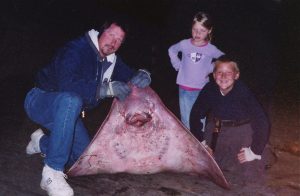
Size: Reaches eight feet in length and to over 200 pounds. Those caught at piers rarely exceed 100 pounds in size although two big skates, one at the Cayucos Pier in July 2004 (estimated at 5 feet by 5 feet) and another one taken at the Trinidad Wharf in the summer of 1996 (4 1/2′ wide and 5 1/2′ long), seemingly were over the century mark.
Range: Cabo Falsa, southern Baha California, and Gulf of California, to the East Bering Sea and Aleutian Islands, at least west to Unalaska Island; also eastern Gulf of Alaska. Considered common Gulf of Alaska to southern California although rarely seen south of Point Conception.
Habitat: Generally found in water of moderate depth although ranges from the shallows to a depth of at least 1,640 feet and possibly 2,624 feet; luckily for pier fishermen, they’re also found over sandy-shore beaches and in bays.
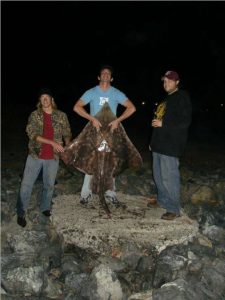 Piers: A few are caught each year, generally at piers north of Point Conception. Best bets: Pismo Beach Pier, Morro Bay Wharf, Cayucos Pier, Seacliff State Beach Pier, Santa Cruz Wharf, San Francisco Municipal Pier, McNear Park Pier, Fort Baker Pier, Pacifica Pier, Trinidad Pier, Del Norte St. Pier (Eureka) and the B St. Pier (Crescent City).
Piers: A few are caught each year, generally at piers north of Point Conception. Best bets: Pismo Beach Pier, Morro Bay Wharf, Cayucos Pier, Seacliff State Beach Pier, Santa Cruz Wharf, San Francisco Municipal Pier, McNear Park Pier, Fort Baker Pier, Pacifica Pier, Trinidad Pier, Del Norte St. Pier (Eureka) and the B St. Pier (Crescent City).
Piers: A few are caught each year, generally at piers north of Point Conception. Best bets: Pismo Beach Pier, Morro Bay T-Piers, Cayucos Pier, Seacliff State Beach Pier, Santa Cruz Wharf, Pacifica Pier, San Francisco Municipal Pier, Paradise Park Pier, McNear Park Pier, Fort Baker Pier, Del Norte St. Pier (Eureka), Trinidad Pier, and the B St. Pier (Crescent City).
Shoreline: An occasional catch for northen California fisherman in Humboldt and Arcata Bay.
Boats: A few are reported from boaters and kayakers fishing in Humboldt and Arcata Bays.
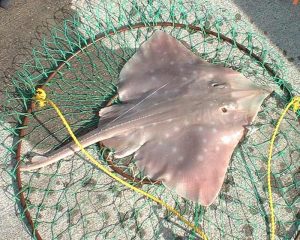 Bait and Tackle: Due to their potential size, medium to heavy tackle should be used. However, most biggies are caught by anglers seeking other species, few anglers fish specifically for skates. Most any bait will tempt a skate but squid, clams, ghost shrimp, marine worms, and small fish seem to work best.
Bait and Tackle: Due to their potential size, medium to heavy tackle should be used. However, most biggies are caught by anglers seeking other species, few anglers fish specifically for skates. Most any bait will tempt a skate but squid, clams, ghost shrimp, marine worms, and small fish seem to work best.
Food Value: Like guitarfish, skates when used for food are really delicious. They have a firm texture with no apparent flakes and a mild taste. The fat content is low. In Europe, where skates are considered a delicacy, the fillets (from th wings) are usually poached, steamed or pan-fried in butter. Anothr method is to cut off the skin around the wings and then use cookie cutters to punch out pieces of meat that are somewhat similar in taste and texture to scallops. Many stories tell of skate being sold in stores as scallops but some experts say that it is doubtful, that the differences are two pronounced. Deep-frying is the most common method of cooking for skate prepared in this manner.
Comments: Far less common than bat rays but the average big skate taken is fairly good size. According to the CA DF&G, “skates have paired electric organs along the sides of their tails, which generate weak, low-voltage electric currents believed to be of use in intra-specific communication, possibly for mate recognition or to demonstrate aggression. These electric currents are not harmful to humans.”
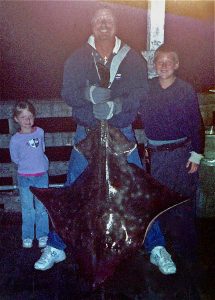
Big Skate—Although fairly uncommon, the ones that are caught are often large in size.
≈ 200 Lbs. — Redondo Pier No. 2, Il Sherard, January 12, 1918
Source: Los Angeles Times, January 13, 1918
≈ 150 Lbs. — Hotel Del Coronado Pier, December 19, 1898
Source: Los Angeles Times, December 19, 1898
130 Lbs. — Capitola Wharf, Early 2000’s
Source: Capitola Wharf Bait Shop
109 Lbs. — Hermosa Beach Pier, Osborne Schmidt, August 8, 1936
Source: Los Angeles Times, August 9, 1936
≈ 100+ Lbs. — Cayucos Pier, July 2004 (100+ pounds, 5” wide and 5’ long)
Source: Glenda, The Tidepool B&T, Cayucos
≈ 100+ Lbs. — Trinidad Pier, Rosie, March 1997 (100+ pounds, 4 ½’ wide and 5 ½’ long)
Source: Salty’s Bait and Tackle, Trinidad
≈ 100+ Lbs. — Princeton Pier, Ray Blair & Albert Frush, October 23, 1932
Source: San Mateo Times, October 25, 1932
≈ 100+ Lbs. — Santa Cruz Wharf, Nick Bosano, June 30, 1932
Source: Santa Cruz Sentinel, July 1, 1932
≈ 100+ Lbs. — Santa Cruz Wharf, March 26, 1931
Source: Santa Cruz Evening News, March 27, 1931
≈ 100 Lbs. — Railroad Wharf (Santa Cruz), W. R. Manning, November 19, 1900
Source: Santa Cruz Evening Sentinel, November 20, 1900
95 Lbs. — Morro Bay North T-Pier, December, 1999
Source: Pier Fishing In California
93 Lbs. — Santa Cruz Municipal Wharf, April 1926
Source: Santa Cruz Sentinel, April 10, 1926
75 Lbs. — Santa Cruz Municipal Wharf, February 14, 1933
Source: Santa Cruz Sentinel, February 15, 1933
75 Lbs. — Seacliff Pier, J. Bligh, March 1931
Source: Santa Cruz Sentinel, March 25, 1931
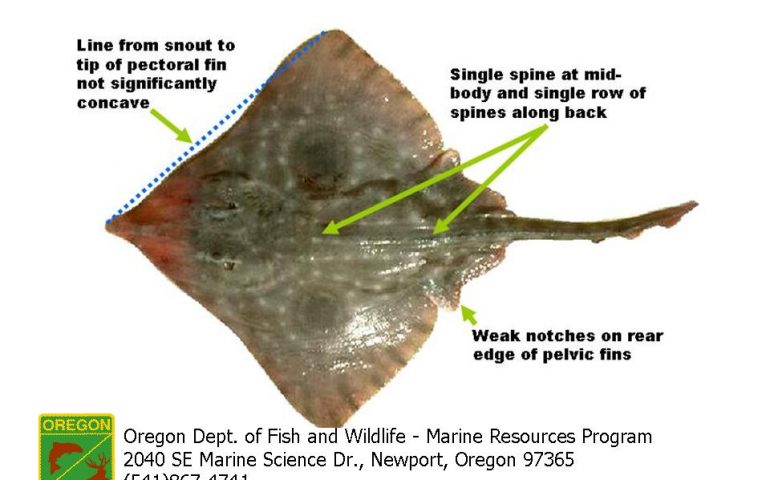
My husband and I just caught a skate longer then me ” I,m 5″3″ and about 125 lbs The wings alone were around 100 lbs.’ We were fishing off the jetty in Westport WA.’
Carol, It certainly sounds like a big skate. Did you get any pictures?
Best wishes, Ken
a close friend landed one at the Imperial Beach Pier in San Diego